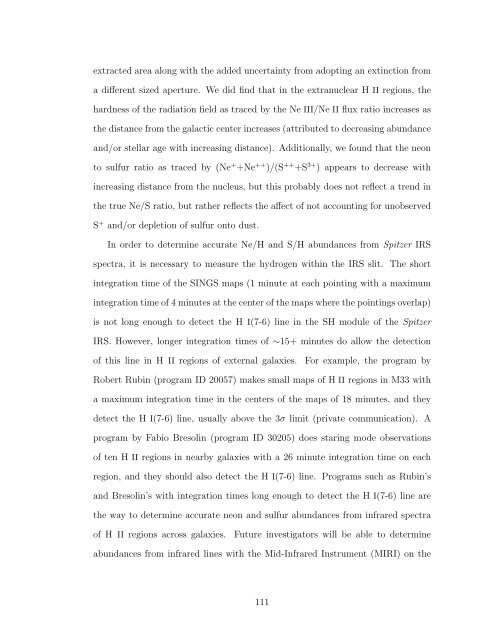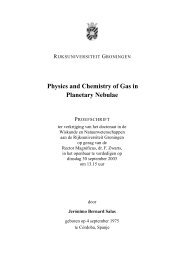TRACING ABUNDANCES IN GALAXIES WITH THE SPITZER ...
TRACING ABUNDANCES IN GALAXIES WITH THE SPITZER ...
TRACING ABUNDANCES IN GALAXIES WITH THE SPITZER ...
Create successful ePaper yourself
Turn your PDF publications into a flip-book with our unique Google optimized e-Paper software.
extracted area along with the added uncertainty from adopting an extinction from<br />
a different sized aperture. We did find that in the extranuclear H II regions, the<br />
hardness of the radiation field as traced by the Ne III/Ne II flux ratio increases as<br />
the distance from the galactic center increases (attributed to decreasing abundance<br />
and/or stellar age with increasing distance). Additionally, we found that the neon<br />
to sulfur ratio as traced by (Ne + +Ne ++ )/(S ++ +S 3+ ) appears to decrease with<br />
increasing distance from the nucleus, but this probably does not reflect a trend in<br />
the true Ne/S ratio, but rather reflects the affect of not accounting for unobserved<br />
S + and/or depletion of sulfur onto dust.<br />
In order to determine accurate Ne/H and S/H abundances from Spitzer IRS<br />
spectra, it is necessary to measure the hydrogen within the IRS slit. The short<br />
integration time of the S<strong>IN</strong>GS maps (1 minute at each pointing with a maximum<br />
integration time of 4 minutes at the center of the maps where the pointings overlap)<br />
is not long enough to detect the H I(7-6) line in the SH module of the Spitzer<br />
IRS. However, longer integration times of ∼15+ minutes do allow the detection<br />
of this line in H II regions of external galaxies. For example, the program by<br />
Robert Rubin (program ID 20057) makes small maps of H II regions in M33 with<br />
a maximum integration time in the centers of the maps of 18 minutes, and they<br />
detect the H I(7-6) line, usually above the 3σ limit (private communication). A<br />
program by Fabio Bresolin (program ID 30205) does staring mode observations<br />
of ten H II regions in nearby galaxies with a 26 minute integration time on each<br />
region, and they should also detect the H I(7-6) line. Programs such as Rubin’s<br />
and Bresolin’s with integration times long enough to detect the H I(7-6) line are<br />
the way to determine accurate neon and sulfur abundances from infrared spectra<br />
of H II regions across galaxies. Future investigators will be able to determine<br />
abundances from infrared lines with the Mid-Infrared Instrument (MIRI) on the<br />
111













